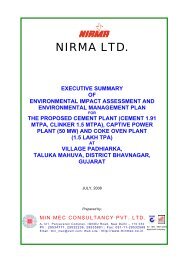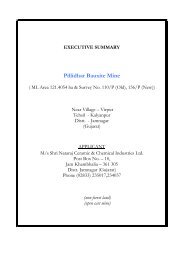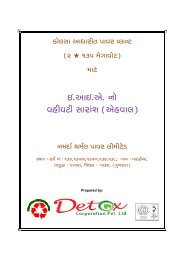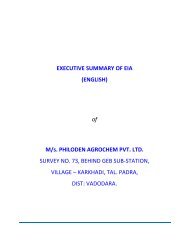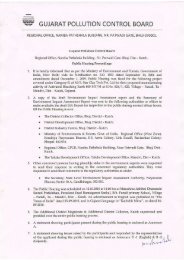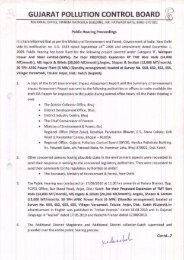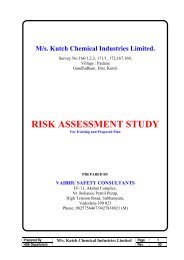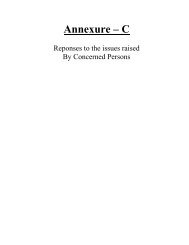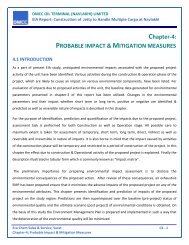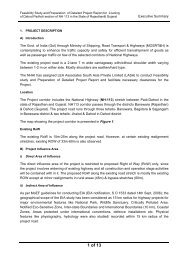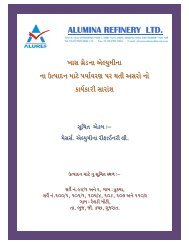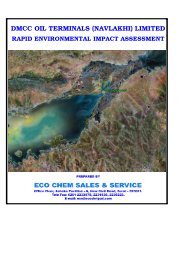4. description of the environment - Gujarat Pollution Control Board
4. description of the environment - Gujarat Pollution Control Board
4. description of the environment - Gujarat Pollution Control Board
You also want an ePaper? Increase the reach of your titles
YUMPU automatically turns print PDFs into web optimized ePapers that Google loves.
Final Feasibility Report<br />
Preparation <strong>of</strong> Feasibility– cum-Preliminary Design for 4/6 Laning<br />
<strong>of</strong> Jetpur-Somnath section <strong>of</strong> NH 8D, Package No:<br />
NHAI/DBFOII/DPR/02<br />
GEOLOGY<br />
ROCKS<br />
Recent: Alluvium, Blown Sand & Miliolite Sand.<br />
Sub-Recent Pleistocene: Limestones, Sandstones,<br />
Shales and Laterite & Bauxite<br />
Upper Cretaceous to Palaeocene: Diorites, Basic<br />
Intrusives.<br />
Deccan Trap: Felsite, Rhyolite & Pitchstone<br />
Flows,Basalts Andesite, Trachyte Flows.<br />
Holocene Deposits<br />
Mesozolcs<br />
Sea<br />
Porbandar<br />
Ranavav<br />
Buffer Zone (Upto 15 km<br />
from corridor)<br />
Taluka boundry<br />
MINERALS<br />
Mangrol<br />
Bauxite Chalk Lead / Zinc / Copper<br />
Calcite Ochre Sandstone & O<strong>the</strong>r building stone<br />
Gypsum Salt Quartz and silica sand<br />
Limestone Agate<br />
Fire Clay Nepheline Syenite<br />
5 0 5<br />
Kilometre<br />
10 15<br />
<strong>4.</strong>3.3 Soil<br />
Project Corridor<br />
Arabian Sea<br />
VOLUME III:<br />
ENVIRONMENTAL IMPACT ASSESSMENT<br />
Upleta<br />
Vanthli<br />
Manavadar<br />
Padadhari<br />
Lodhika<br />
Somnath<br />
Jetpur<br />
Rajkot<br />
Wankaner<br />
Kotda Sangani<br />
Gondal<br />
Jam Kandorna<br />
chorwad<br />
Figure 4-2: Geology <strong>of</strong> <strong>the</strong> Project Area<br />
The geographical formation <strong>of</strong> Saurashtra region is <strong>of</strong> volcanic origin, hence <strong>the</strong> soils <strong>of</strong> Rajkot<br />
district are derived from trap rock. The land <strong>of</strong> <strong>the</strong> project region that falls in Rajkot district is<br />
mainly divided into two types:<br />
Salty land is mainly <strong>the</strong> type <strong>of</strong> land in Morbi and Maliya and black, loamy soil is mainly present<br />
in Jetpur and Dhoraji talukas. The soil <strong>of</strong> <strong>the</strong> project region that falls in Jetpur taluka is red soil. In<br />
Junagadh district, <strong>the</strong> soils are formed partly from sedimentary rocks and partly from igneous<br />
rocks. They are calcareous in nature, rich in potassium content but deficient in nitrogen and<br />
humus. The main types <strong>of</strong> soils in <strong>the</strong> district are black, medium black, alluvial soil in <strong>the</strong> lowlying<br />
area, calcareous and brackish. The black soil is found in parts <strong>of</strong> Vanthali, Manavdar and<br />
Keshod talukas excepting <strong>the</strong> Ghed area. Most <strong>of</strong> <strong>the</strong> villages in Junagadh, Malia talukas have<br />
medium black soil. The alluvial soil in <strong>the</strong> low-lying area, known as ‘Ghed’, comprises parts <strong>of</strong><br />
Keshod, Mangrol and remains inundated during monsoon. The brackish soils are mostly found<br />
near <strong>the</strong> coastal belt <strong>of</strong> Mangrol, Malia and Veraval talukas and represent <strong>the</strong> degeneration <strong>of</strong><br />
Dhoraji<br />
Junagarh<br />
Maliya<br />
Talala<br />
Malia<br />
Miyana<br />
Morbi<br />
Una<br />
Jasdan<br />
4-4



